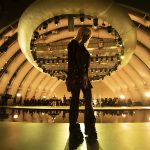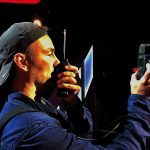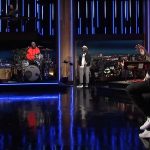“Light Night Conversations” is a new recurring series of PLSN interviews with the lighting designers of the various late-night talk shows on television. These designers face many interesting design challenges that go beyond simply lighting a desk and an interview area, which, for the record, is not as simple as it may appear. Late-night LDs need to light musical guests, often both inside and outside the studio, design sketch comedy setups, audience interactions, man-on-the-street exchanges and full show location remotes. We start on the West Coast with Jimmy Kimmel Live’s LD Christian Hibbard. –ed.

Lighting Designer Christian Hibbard has been lighting ABC’s Jimmy Kimmel Live! show for more than seven years. Prior to being the LD, Hibbard started on the show programming the lights when it debuted in January 2003. Jimmy Kimmel Live! is now the longest running late-night talk show on television. The show tapes at the historic El Capitan Entertainment Centre in Hollywood, CA. In addition to the sit-down interviews, there are a lot of improvisational bits with audience and man-on-the-street segments, a number of sketch comedy sets and top name musical acts that perform in a variety of different production areas in and around the studio.
The main production spaces for Kimmel include the home base area where Kimmel conducts the interviews, along with areas on the stage for stand-up comedy bits and smaller, more intimate musical acts; the outdoor stage; the lobby stage for musical acts; and occasionally Hollywood Boulevard in front of the El Capitan for large musical acts like Taylor Swift or Van Halen. With the exception of moving lights, the interior studios are almost entirely lit with LED lighting equipment.

PLSN: Please talk a little bit about how your lighting supports the style and the overall look of the show.
Christian Hibbard: We love live comedy; we can do a lot of unrehearsed, unscripted set up the environment kind of things. It’s a bit of a hybrid, I can go from two guys sitting at a desk to them changing environments, getting up and walking around to do whatever. We need to be able to make those kinds of transitions pretty seamlessly. I doubt the home viewer really notices that much, but it’s a lot for us here to make that work.
I try to light the show in a way so when a viewer turns on the TV, they quickly know that it’s our show. If you look at Kimmel, you know it’s Kimmel with the blues and the hues; these colors.
A lot of this has to do with how I work with the video controller so the black levels don’t show and things like that to create the look that we have for Kimmel. Dan Jones, the video engineer for the show, and I talked when I took over, because I thought it was a little too dark perhaps; they really wanted it for late-night dark blue thing. I lifted up the black levels a little bit and I shifted my lighting out of the blue range a little bit. It’s just a bit different than some of the other late-night shows, and I think that’s a good thing. It reflects the show that Jimmy Kimmel wants it to be.
What are some of the primary challenges and what are the solutions you’ve found worked for lighting this show?
We love to use real people on the show; not actors. A professional actor finds his light, they will know subconsciously. When they’ve stepped out of the light; they’ll step back in. We occasionally do bits with pros, and I can light them a little more dramatically, with more mood. Like with Betty White; she went on unrehearsed and she ran out and absolutely hit the mark that she was shown from backstage because, she is Betty frickin’ White. Regular people from the audience don’t do that.
My biggest challenge is that, generally, I’ll get a non-actor, and they only want to get out of the spotlight. You have to light an environment differently when you’re dealing with people whose natural instinct is to step out of the light so they can see. We deal with that a lot here. It’s almost like an Improv a lot of times here. We love setting people up and seeing what they’ll do. You have to give them the right environment to work in and not overwhelm them with lighting. I use softer sources; working a generic wash. We pick which cameras are the main camera; whatever happens we’re cueing to that camera, but we don’t give them marks on the floor to hit.
My background is just a general wash backlight. I have a key on both sides, but I’m not getting in there and really noodling for them to hit a mark and then have them turn and have a light hit them on that mark. Those kinds of things are very rare for me. Most of the time, I’m lighting in way that, wherever they hit, the mood I’m trying to set, will work. Basically, I’m creating more environmental lighting. I light an environment, then I let them work in that environment.

What are some of your key equipment choices for the main studio, and how do they support what you’re trying to achieve?
Well, we went all LED three years ago; everything’s LED. I’m a big fan of the [Cineo Lighting] TruColor technology with the HS and LS Cineos. I use that quite a lot because it keeps my soft light source for face light. Then I have the Prism [Projection] RevEAL Studio.3 Fresnels and the Prism ellipsoidals; those are my go-to, most-of-the-time lights. Then I have a smattering of the Arri LED Fresnels for key lights. They help for key light where I actually do know where the guest is going to sit in a chair, because it’s physically there for them to sit on, and things like that. That’s most of what I have. I have more LED stuff, I have a bunch of different lights. I have [Philips Vari-Lite] VL880’s, VLX’s, VLX3’s for the music;
I also have some VL3K’s. Those all get used.

What are some of your key equipment choices for the 40-by-40-foot outdoor stage, and what is your approach to that space?
It’s interesting, since the outside stage is a daytime show about eight months a year. It can be summertime, it can be wintertime. I can have 30 people out there, I can have three people out there. I need fixtures that can do a lot of different things, you know, that look good. So I want brighter sources and bigger front ends. A lot of times you’re just seeing dots of light; you’re not actually seeing beams of light. I’m really lucky to have equipment from PRG since they manufacture their own Bad Boys and Best Boy Spots; those lights are great, and they have a big aperture. I have a lot of those lights. I also have a lot of VL5 Arcs. In the summertime, I can take the VL5 Arcs, put stipple lenses in them, and just get 800 foot-candles out of the damn thing.
I also have some [Clay Paky] Sharpys and a lot of video elements. We have a 6mm
video wall from Sweetwater. The outdoor show can be a lot of different things, depending on the time of year and the band. There are times, midsummer, when I’ll have 30 people on stage, and it’s just like a daytime festival. It’s just big and you know, crazy. I think the key to that stage is having that versatility.
When you work with a guest band, is there a lot of input from the band’s designer, or is a lot of it what’s up to you?
It really depends; everybody’s different. There are some bands that come in and work with what we have and there are some bands that want to bring their whole rig and want to install their rig on our stage, which we try to avoid. It does happen, occasionally. Then there are other people who give us nothing, and everywhere in between.
It’s a delicate balance, because if an LD comes in and they know what they want, I love it. They know the band. Short of that, I try really hard to work with whatever the band wants, to give them the best look. I think that we, the show — we worked really hard to change the way television feels; a lot more like a live show. We’re not afraid of not using front light. We’re not afraid of very hard colors. I really try and find out whatever is appropriate for the band.

How do you handle the lobby stage?
The lobby stage is where we do the majority of our music. It’s tiny, so it can be a challenge; the ceiling is only about eight feet high. The biggest element in this space is that we have about 35 feet of 6mm video wall that we run off the [PRG] Mbox media server. Since it’s television, mostly the audience sees the close up of the lead singer. Having that video wall gives us a lot of flexibility for that.
I’ve got [Philips Vari-Lite] VL880s over the stage and a lot of conventionals that I can play with as needed. I’ve got floor lights to put out there too if I need. We try and change it up as much as we can for each band out there. There are always new fixtures coming out, or we’ll bring in lights that we have around, or even turn things off. I always tell people, “If you’re tired of looking at what you have, just turn half of it off and start over.”
We also have a small area on the show’s main stage where we will do music sometimes as well. If it’s just a single, just a person with a guitar, we’ll put them on the main stage because they want that more intimate vibe. If there are a lot of people, we try to put them on the outside stage.
Do you have any issues balancing the video with the lighting so the video walls don’t overpower the lighting?
No, since I have control of the video it’s not an issue. When we first got the video wall, we sat down with a video engineer and set up base levels for it, color, and everything else. Then with the Mbox media server it’s easy enough to take down. We do all the media. Obviously, bands will come in sometimes with their own media. Our video wall is like 512 pixels high by 5,400 pixels wide. It’s not something most people are used to.. Some bands will generate content, and if they have content that’s generic enough, that will work. If you’ve got a 16×9 video format you want to play in, it’s not exactly built for that.
In the summertime, outside, balance, in general, is an issue, because for a few months, the sun is setting as we’re shooting. There are huge ambient light level changes when we go from 400 foot-candles to 50 during a song because the sun set behind a building. We definitely have to chase that kind of stuff. We build inhibitive subs, we do everything that we can to kind of just ride it out as it goes down.
What is the lighting console that you are using, and who is your programmer?
We are using PRG V676 consoles, both inside and out. Kille Knobel is my main programmer inside. She’s Pearl Jams’ LD, and it’s just amazing that she’s here. Then my gaffer is William Peets. They have both been with the show for six years now.
As much as I say I’m out there balancing my levels during the time the sun is setting, Bill is the one out there while I’m in the booth doing the first five acts of the show. Bill is the one out there with the meter and the walkie talkie, you know, trying to ride that horse of sunlight down for me. We talk about it beforehand, but he’s the one who has to do it.
What would you say have been the interesting challenges or solutions that you have come up with during your tenure on the Jimmy Kimmel Live! show?
I think the most challenging thing for most people is probably the fact that you have to program the outside stage in daylight. The band shows up at noon, then the show is at six. They’ve got five hours to program their two songs, and then we’ll never see it, especially in the wintertime, at night, until we’re on air. Basically we just have to treat it like an old-school festival where you’ve got to program in the daytime and then you kind of hope for the best at night. The way we accomplish that is that we do it enough that we kind of know what the levels are going to be. Then being really smart about inhibitive subs and having a lot of ability to control the levels across the board. Then having a really great video engineer who can ride it with you, because we’re all in that boat together. We’re all sort of riding the sunset out. That sort of ballet of doing the show at sunset.
And it’s beautiful. I mean, obviously, a sunset shot is perfect. The sky gets to that right moment, and there are some clouds — it’s gorgeous.
Jimmy Kimmel Live! airs weeknights at 11:35, 10:35c on ABC.


